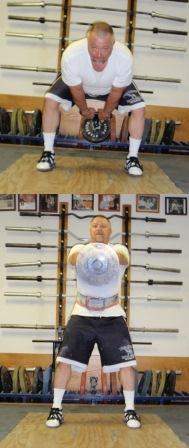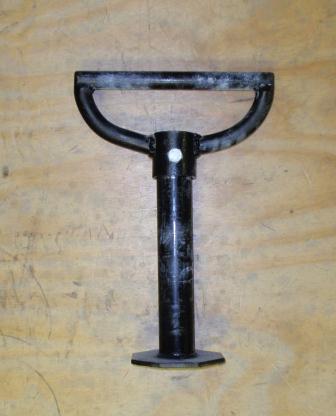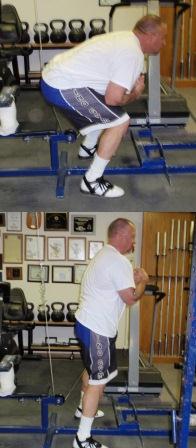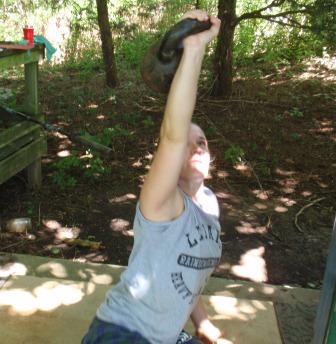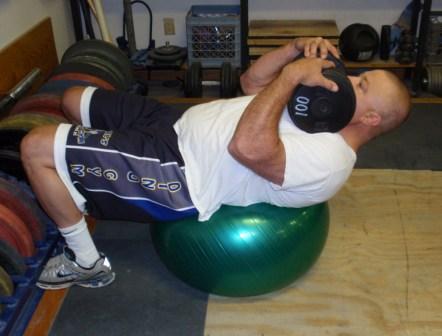The Stiff-Legged Deadlift Must Die
By Dan Wagman, PhD, CSCS
I’m glad that Al’s article on the Romainian Deadlift (RDL) and Stiff-Legged Deadlift (SLDL) mentioned the dangers of the SLDL. Everything about the SLDL is contrary to proper lifting technique, biomechanics, and physiology-and as such increases injury risk immensely. And since we’re talking about the back, an injury there can be life changing and lifting career ending. Please let me explain…and I’ll do this as briefly as possible and in a step-by-step sequence.
A properly executed RDL reduces the risk of injury over the SLDL many fold. For one, a properly executed RDL allows the lifter to simply deadlift the barbell off the ground; this means that proper lifting technique can be employed before you even start doing a RDL. Then, as you commence the RDL, the barbell is slid down the thighs, over the knees, and about half way down the legs, while at all times remaining in contact with the body. This is achieved by keeping the back in a neutral position (flat) and by shifting the center of mass back toward your heels as much as possible. If you find yourself losing balance backwards and your toes popping up a bit, then you’re doing a proper RDL. By keeping the back flat and keeping the center of mass as close to the coronal plane* as possible, the shearing forces upon the lower back are minimized. Research on the squat has demonstrated clearly and unequivocally, how the more the center of mass moves away from the coronal plane (forward), by as an example doing a low-bar sq compared to a high-bar sq, shearing forces on the lower back increase many fold. (Certain dl comparison studies have demonstrated this, too.)
So what about shearing forces? Whenever you lift something, joints move, and shearing forces exist. But by observing proper lifting technique, grounded in sound biomechanics, these shearing forces are something your body can handle and adapt to so that they become a non-issue. And so in the low-bar squat, even though the shearing forces upon the lower back are greater than in the high-bar squat, since proper lifting technique can nevertheless be maintained, these forces don’t add up to an increased injury risk. Not so in the SLDL!
Some of the technique strategies necessary to reduce shearing forces upon the lower back when you lift is to bend the knees, keep the back in neutral, and keep the center of mass as close to the coronal plane as possible. This can all be achieved with every pull off the ground-except the SLDL. And what makes the SLDL particularly insidious is that execution of this lift requires you to violate all principles of proper lifting. And that’s why this lift must die…
- Whenever the center of mass moves forward…you’re increasing shearing forces upon the lower back; you can’t do a SLDL with the bar close to the body.
- Whenever you lift something with locked knees…you’re increasing shearing forces upon the lower back; this is one of the chief aspects resulting in a barbell away from your body.
- Whenever you round your back, you’re taking the curvatures out of your spine, thus reducing the structural strength of the spine, thereby increasing forces upon all vertebrae of the spine…and you’re also increasing shearing forces upon the lower back; you couldn’t lift with neutral spine (flat back) even if you tried when your knees are supposed to remain locked.
- Whenever you lift more weight…you’re increasing shearing forces upon the lower back; but in the SLDL this occurs due to poor technique that places anatomical structures (tendons, ligaments, discs, muscles, etc.) at additional risk by ostensibly weakening them.
Up until now I’ve withheld personal opinion and just shared scientific fact. But based on these scientific facts, my personal opinion is that if the IAWA Worlds had the SLDL as a contested lift, I’d only do a token lift with the minimum amount possible, even if that meant losing the worlds by 10 pounds. And not trying to pick on Al here, I would like you to consider that him having done SLDL’s for 20 years without injury is simply a function of luck. If I were him, I’d consider the facts of biomechanics and I’d stop doing SLDL’s now and thank Lady Luck every day that I made it through the mine field intact.
So now some of you might be thinking that, “Yeah, well, but the SLDL does help my deadlift by giving me more strength off the ground.” Guys, let’s be honest here, that’s just conjecture based on what came out of the “Golden Age of Lifting.” It can be argued that these guys gave rise to the field of exercise science. And now that it has advanced, we should not hold on to old and unproven myths, but embrace the advances in knowledge these guys laid the foundation for. So, sure, you might think that SLDL’s will help you get the barbell of the ground, because that’s what you feel. But what you’re feeling there is just an acute sense of what’s going on due to a new exercise-it’ll fade…and the feelings are not a reflection of reality. Research has shown that in an effort to get the barbell moving off the ground, you need more speed-not a violation of good lifting form and enough luck to survive that. So you’d be much better off training high pulls than SLDL’s to increase your pull off the ground. There’s a reason weightlifters tend to be great deadlifters…and it’s not because they do SLDL’s.
Overall, there is absolutely no reason to do the one lift that violates all principles of proper lifting. And as to being a contested lift in IAWA and USAWA…who cares. Is it worth the risk? At the end of the day, that’s your decision. I can only hope that you’ll be able to take the above as useful evidence to derive at a more informed decision. As for me, SLDL RIP.
*Imagine looking at a person from the side and dividing that person into equal halves front and back. The center line that divides front and back is the coronal plane.
